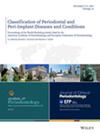The influence of prosthetic designs on peri-implant bone loss: An AO/AAP systematic review and meta-analysis
Abstract
Background
Implant prosthetic design significantly impacts peri-implant health. This systematic review and meta-analysis explored emerging concepts in prosthetic considerations, appraising the level of evidence and clinical significance of these suprastructures on peri-implant marginal bone loss (MBL).
Methods
An electronic search of three databases and a manual search of peer-reviewed journals for relevant articles published in English between January 1980 and December 2023 were performed. Eligible studies featured dental implants restored within ≥12 months, with ≥10 implants in each group. Inverse variance meta-analyses were performed to compare various prosthetic factors and their impact on MBL and the risk of peri-implantitis.
Results
Screw-retained versus cement-retained prostheses demonstrated no significant difference in MBL (six articles, p = 0.51). Nonsplinted implants exhibited lower MBL compared to their splinted counterparts (eight articles, p = 0.04). Platform-switched abutments were correlated with reduced MBL compared to platform-matched ones (20 articles, p < 0.0001). Internal connections, particularly conical ones, displayed less MBL than external connections (20 articles, p < 0.0001). The crown-to-implant ratio did not significantly affect MBL (five articles, p = 0.32). Abutment heights ≥2 mm are associated with less MBL than heights <2 mm (12 articles, p < 0.0001). Implementing a one abutment-one time protocol resulted in less MBL than repeated abutment disconnections (10 articles, p < 0.0001). Emergence angles <30° and a concave/straight profile led to lower peri-implantitis risk (two articles each; p = 0.05 and p = 0.03, respectively).
Conclusions
Nonsplinted implants, platform-switched abutments, abutment heights ≥2 mm, and a one abutment-one time approach yielded significant reductions in MBL compared to their counterparts. Furthermore, emergence angles <30° and a concave/straight emergence profile were linked to decreased peri-implantitis risk. Meanwhile, factors such as screw-retained versus cement-retained prostheses and crown-to-implant ratio yielded no significant difference in MBL.
Plain Language Summary
The design of implant-supported tooth replicas plays a key role in keeping the surrounding gums and bone healthy. This study reviewed research from 1980 to 2023 to examine how different design features of these restorations impact oral tissue health. A total of 93 studies were included, focusing on patients aged 18 years and older, with at least 10 patients in each group. The findings showed that individual tooth replicas (rather than splinted ones) led to better gum health. A horizontal offset at the implant–replica junction helped reduce bone loss. Implants with internal connections (inside the implant body) performed better than those with external connections. Tooth replicas with narrow contours at the implant junction were more beneficial than convex shapes. Additionally, using abutments taller than 2 mm and minimizing the number of times an abutment is removed during fabrication helped preserve surrounding tissues. These findings highlight how careful implant design can improve long-term oral health, reducing complications and maintaining stability around dental implants.


 求助内容:
求助内容: 应助结果提醒方式:
应助结果提醒方式:


